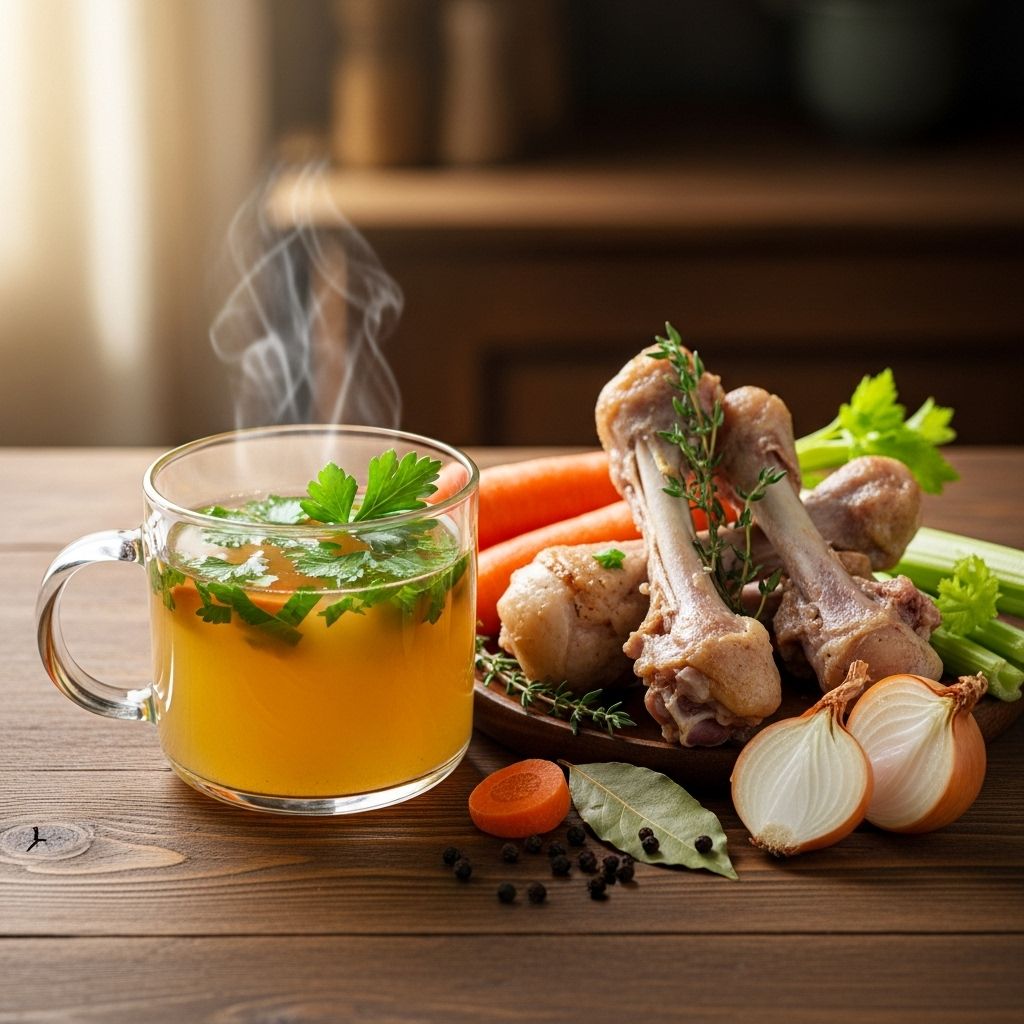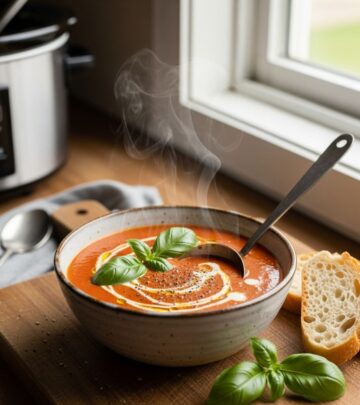Homemade Chicken Bone Broth: A Nourishing Classic
Discover the secrets to making rich, flavorful, and nutritious chicken bone broth with simple ingredients and easy steps.

Chicken Bone Broth: A Nourishing, Flavorful Staple
Chicken bone broth is more than just a warming, comforting beverage or an essential soup base—it’s a time-honored tradition and a vital building block for countless dishes. Boasting a deep, savory flavor and an impressive nutritional profile, bone broth has roots in cuisines across the world. From homestyle chicken noodle soup to exquisite restaurant-quality risottos, quality chicken bone broth elevates meals with its richness and body.
What is Chicken Bone Broth?
Chicken bone broth is a savory liquid made by simmering chicken bones (often with meat still attached) along with aromatic vegetables, herbs, and spices. Slow-cooked for hours, the process extracts vitamins, minerals, collagen, and gelatin from the bones and connective tissues, resulting in a nourishing, golden broth celebrated for both its flavor and health benefits.
Chicken Bone Broth vs. Stock and Regular Broth
- Bone Broth: Simmered for a long time (8 to 24 hours), extracting collagen and minerals, yielding a richer, more gelatinous texture.
- Stock: Cooked for 4-8 hours using bones (sometimes with a little meat), stock is less thick than bone broth but richer than regular broth.
- Regular Broth: Usually made by simmering meat (not bones) and vegetables for a short period, resulting in a thinner, lighter liquid.
Benefits of Chicken Bone Broth
Chicken bone broth is revered for both its culinary versatility and its numerous health perks. Popular as a restorative drink or the backbone of nutrient-dense recipes, the key benefits include:
- Rich in Collagen and Gelatin: Supports joint health and enhances the texture of dishes.
- High Mineral Content: Contains calcium, magnesium, phosphorus, and potassium.
- Gut-Friendly Compounds: Gelatin and amino acids may help support gut health.
- Immune Support: Sipped as a warm beverage, it offers comforting hydration and nourishment, ideal during recovery from illness.
- Culinary Versatility: Forms the basis for soups, risottos, gravies, stews, and sauces.
Ingredients for Classic Chicken Bone Broth
Making bone broth is largely about infusing water with flavor and nutrients from bones, vegetables, and aromatics. Here’s a classic ingredient list for homemade chicken bone broth:
- Chicken Bones: Carcasses, backs, necks, wings, or a mixture. Leftover roasted chicken bones add great flavor.
- Vegetables: The basics include onions, carrots, and celery, often called mirepoix.
- Herbs and Seasonings: Fresh parsley, thyme, bay leaves, garlic cloves, peppercorns, and a touch of salt.
- Water: Cold, fresh water to cover the bones and vegetables.
- Optional Additions: Apple cider vinegar (helps extract minerals from bones), leeks, parsnips, or leftover vegetable scraps.
Step-by-Step Instructions: Making Chicken Bone Broth
Follow these easy steps to create your own rich and flavorful chicken bone broth at home:
- Prepare the Ingredients: Gather chicken bones and, if desired, leftover meat. Chop vegetables into large chunks. Rinse bones if they’re not already clean.
- Combine in a Large Pot: Place bones in a large stockpot or slow cooker. Add onions, carrots, celery, herbs, garlic, peppercorns, and any additional vegetables. Pour in enough cold water to cover all ingredients by about 1-2 inches.
- Add a Splash of Acid: For extra mineral extraction, add 1-2 tablespoons of apple cider vinegar or lemon juice to the water.
- Simmer Gently: Bring the pot to a gentle boil, then immediately reduce heat. Simmer gently, partially covered, for 12 to 24 hours. Occasionally skim off foam and impurities that rise to the surface with a spoon.
- Monitor Water Level: Add hot water as needed to keep bones covered throughout the cooking process.
- Strain the Broth: When richly flavored and golden, let the broth cool slightly. Strain through a fine-mesh sieve into another pot or heatproof container, discarding solids. For an extra-clear broth, strain a second time through cheesecloth.
- Cool and Store: Cool to room temperature. Refrigerate for up to 5 days or freeze in airtight containers (or ice trays for smaller portions) for up to 6 months.
Pro Tips for Perfect Bone Broth
- Roast the Bones First: For deeper flavor, roast chicken bones in a hot oven (400°F/200°C) for 30–40 minutes before simmering.
- Low and Slow: A gentle, slow simmer yields the best results, extracting maximum nutrition and flavor while minimizing bitterness.
- Skim Frequently: Removing foam and fat results in a clearer, cleaner-tasting broth.
- Don’t Oversalt: Wait to season heavily until you’re ready to use the broth, especially if you plan to reduce or use in another recipe.
- Fat Cap: The yellow fat that solidifies atop refrigerated broth helps seal in freshness. Remove before reheating, or use as a cooking fat if desired.
How to Use Chicken Bone Broth
This versatile broth excels as both a healthy beverage and a base for countless recipes:
- Sipping Broth: Warm with a sprinkle of fresh herbs and a dash of salt for a comforting drink.
- Soup Base: Perfect for classic chicken noodle soup, vegetable soups, or Asian-inspired broths.
- Cooking Liquid: Use instead of water for rice, grains, and risottos for an added boost of flavor.
- Sauces & Gravies: A deeply flavored foundation for pan sauces, gravies, and braised dishes.
- Mash & Purees: Enhance mashed potatoes or vegetable purees with a big splash of bone broth.
Storage and Shelf Life
Proper storage helps maximize freshness and food safety. Here’s how:
- Refrigerator: Store cooled broth in airtight containers for up to 5 days. A layer of fat on the surface acts as a natural seal.
- Freezer: Freeze in portioned containers for up to 6 months. Try ice cube trays for quick soup or sauce additions.
Always reheat thoroughly before serving. If broth becomes cloudy, or develops a sour odor, discard immediately.
Nutritional Profile of Chicken Bone Broth
| Nutrient | Approximate Amount (per cup) |
|---|---|
| Calories | 30–60 kcal |
| Protein | 5–7 grams |
| Fat | 0–3 grams |
| Carbohydrates | 0–2 grams |
| Collagen/Gelatin | Varies (often 1–3 grams) |
| Minerals (Ca, Mg, P) | Trace amount, depends on ingredients |
Note: Nutrition content will vary depending on the specific bones, vegetables, and simmering time used.
Chicken Bone Broth Recipe Card
- Prep Time: 10 minutes
- Cook Time: 12 to 24 hours
- Total Time: Up to 1 day
- Yield: About 12 cups broth
Ingredients
- 2–3 pounds chicken bones (necks, backs, carcasses, wings, or leftovers)
- 2 carrots, roughly chopped
- 2 celery stalks, roughly chopped
- 1 large onion, quartered
- 4 garlic cloves, smashed
- 2 bay leaves
- 1 teaspoon black peppercorns
- 1–2 tablespoons apple cider vinegar
- 8–12 cups cold water (enough to fully cover)
- Optional: handful of parsley or thyme sprigs
Instructions
- Place bones, vegetables, herbs, and vinegar in a large stockpot.
- Cover all ingredients with cold water by about 2 inches.
- Bring to a gentle simmer on medium-high heat. Reduce heat to low and simmer gently, uncovered or partially covered, for 12 to 24 hours.
- Skim off foam and excess fat as needed.
- Strain broth through a fine-mesh sieve. Discard solids.
- Cool to room temperature before storing.
Variations and Customizations
- Herb Lovers: Add rosemary, sage, or dill for a fresh herbal boost.
- Spice It Up: Drop in a dried chile or fresh ginger slices for a warming, spicy flavor.
- Vegetable-Rich: Use leftover veggie peels, leeks, or even mushrooms for extra umami.
- Clear Broth: For extra clarity, strain twice or use a fine cheesecloth.
Frequently Asked Questions (FAQs)
Q: Can I use raw or cooked chicken bones?
A: Both work! Roasted bones impart deeper, richer flavor, while raw bones make a lighter, cleaner broth. For best results, try a mix of both.
Q: How long should I simmer bone broth?
A: Simmer for at least 12 hours for a good gel and flavor. For maximum nutrition extraction, go up to 24 hours, adding water if needed to keep bones covered.
Q: Why add vinegar to bone broth?
A: Vinegar helps break down collagen and release minerals from the bones, producing a more nutrient-dense broth. It doesn’t make the broth taste sour.
Q: How can I tell if my bone broth has enough gelatin?
A: Once chilled, well-made bone broth should have a wobbly, jelly-like consistency due to its gelatin content. If it’s still liquid, try a longer simmer or more bones next time.
Q: Is it OK for broth to look cloudy?
A: Yes, a slightly cloudy broth is perfectly normal, especially if simmered a long time or not skimmed repeatedly. It’s still delicious and nutritious.
Summary
Chicken bone broth is a timeless foundation of home cooking, celebrated for its flavor, nutrition, and versatility. Using just a handful of simple ingredients and a little patience, you can produce a rich, restorative broth to nourish your body and enhance your meals. Whether sipped solo or incorporated into recipes, homemade bone broth is a culinary tradition worth mastering.
Read full bio of medha deb












